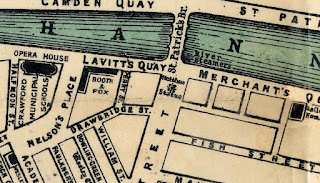On the 16th of February Lieutenant Henry Genochio left his billet at Alexandra Place, St Lukes, shortly after 5pm and headed in the direction of Patrick Street. This British military officer was in his civvies and carrying a revolver and identity card. Just after 9pm he was approached by two members of the Irish Republican Police on Patrick Street and he was arrested.
Alexandra Place, St Luke's, on the north side of the city.
24 year old Genochio was born in Wandsworth and a graduate of Sandhurst military academy. In 1918 he was sent to serve in France at the tail end of the Great War. In 1920 he was sent to Limerick as an intelligence officer where he was involved in the Cahirguillamore raid which resulted in the deaths of five IRA Volunteers.
Cork District Lunatic Asylum
Genochio was taken to the Lunatic Asylum on the Lee Road (Our Lady's Hospital) which was being used as a prison by the Republican Police. This was a precarious time as the War of Independence had just ended and the Civil War was brewing. It was a period of transition between the British and the Provisional Free State Government and in between there were old scores to be settled.
Irish Independent February 18 1922
The British military did not report Genochio missing until the following day but, by then he had already died. At 11am February 17th, Genochio was shot some 200 yards from the entrance gates to the asylum. According to the IRP he was shot in the back by sentries as he tried to escape.
Genochio was shot dead 200 yards to the right of the main gates. Presumably he was making a dash back towards his billet at St Lukes.
The Provisional Government declared that Genochio was arrested because he had stolen jewellery but those accusations were retracted in 1924 and the reason behind his arrest and subsequent death may lie with his previous activities in Limerick. He was buried in Streatham Cemetery London where his grave marker tells of his demise on the Lee Road.
House of Commons debate.

















































